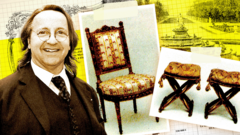The recent furniture fraud that infiltrated the prestigious Palace of Versailles has come to light, involving renowned antiques experts who sold fake royal chairs. This scandal highlights the vulnerability of institutions relying on expert evaluations and calls for greater scrutiny within the art market.
Deception at Versailles: The Furniture Fraud Scandal Unveiled

Deception at Versailles: The Furniture Fraud Scandal Unveiled
A detailed account of the fraudulent antique chairs that sparked a scandal in the French antiques market, revealing the complexities of authenticity and deception.
In the early 2010s, a pair of ornate chairs thought to be linked to the historic Palace of Versailles surfaced in the French antiques market. Allegedly crafted for Marie Antoinette, the final queen of the Ancien Régime, these chairs bore the esteemed seal of Nicolas-Quinibert Foliot, an influential cabinet maker from the 1700s. In 2013, the French government designated them as "national treasures" at Versailles' request. The palace showed interest in acquiring them, but when their price exceeded expectations, the chairs were purchased for an astonishing €2m (£1.67m) by Qatari Prince Mohammed bin Hamad Al Thani.
The antiques market saw a surprising influx of 18th Century royal furniture, including pieces that were claimed to belong to historical figures like Madame du Barry, King Louis XVI's sister Princess Élisabeth, and a pair of stools linked to Princess Louise Élisabeth. Many of these items ended up being purchased by Versailles itself or affluent collectors, while others made their way to prestigious auction houses.
However, in 2016, this wave of princely antiques devolved into a national scandal casting a shadow over France's antiques industry. Authorities uncovered that all these chairs were forgeries. A protracted investigation lasting nine years culminated in a high-profile trial involving Georges "Bill" Pallot, a distinguished antiques expert, and Bruno Desnoues, a celebrated cabinetmaker, who faced charges of fraud and money laundering.
Joining them in the dock was Laurent Kraemer, director of Galerie Kraemer, who was accused of gross negligence for his role in selling the fraudulent pieces. Both Pallot and Desnoues admitted to the charges, while Kraemer and his gallery continue to deny wrongdoing. Their trial is ongoing as the art community grapples with the ramifications of these deceptive practices.
Pallot, regarded as an authority on French 18th-century chairs, initially collaborated with Desnoues in 2007 to see if they could replicate an antique armchair. The project, which began as a whimsical experiment, evolved into a scheme where they managed to produce convincing replicas. By acquiring authentic materials and skillfully aging the wood, the duo created forged masterpieces, complete with imitations of stamps from legendary cabinet makers.
The crafted chairs traversed through various galleries before reaching notable auction houses like Sotheby’s and Drouot, amassing profits that prosecutors estimate exceeded €3m. Investigators were tipped off when the lavish lifestyle of an intermediary drew scrutiny from authorities, leading to an unraveling of this elaborate scheme.
As the trial unfolds, the accusations against Gallery Kraemer raise important questions about responsibility within the art market. Prosecutors argue that despite being initially deceived, the gallery failed to perform adequate authenticity checks before reselling the items at inflated prices. In defense, Kraemer's lawyer insists that the gallery acted in good faith and was also a victim of the fraud.
The unfolding court case serves as a pivotal moment for the French antiques industry, prompting discussions on the need for stricter regulations and oversight within the market to protect institutions and collectors from future deceit.
The antiques market saw a surprising influx of 18th Century royal furniture, including pieces that were claimed to belong to historical figures like Madame du Barry, King Louis XVI's sister Princess Élisabeth, and a pair of stools linked to Princess Louise Élisabeth. Many of these items ended up being purchased by Versailles itself or affluent collectors, while others made their way to prestigious auction houses.
However, in 2016, this wave of princely antiques devolved into a national scandal casting a shadow over France's antiques industry. Authorities uncovered that all these chairs were forgeries. A protracted investigation lasting nine years culminated in a high-profile trial involving Georges "Bill" Pallot, a distinguished antiques expert, and Bruno Desnoues, a celebrated cabinetmaker, who faced charges of fraud and money laundering.
Joining them in the dock was Laurent Kraemer, director of Galerie Kraemer, who was accused of gross negligence for his role in selling the fraudulent pieces. Both Pallot and Desnoues admitted to the charges, while Kraemer and his gallery continue to deny wrongdoing. Their trial is ongoing as the art community grapples with the ramifications of these deceptive practices.
Pallot, regarded as an authority on French 18th-century chairs, initially collaborated with Desnoues in 2007 to see if they could replicate an antique armchair. The project, which began as a whimsical experiment, evolved into a scheme where they managed to produce convincing replicas. By acquiring authentic materials and skillfully aging the wood, the duo created forged masterpieces, complete with imitations of stamps from legendary cabinet makers.
The crafted chairs traversed through various galleries before reaching notable auction houses like Sotheby’s and Drouot, amassing profits that prosecutors estimate exceeded €3m. Investigators were tipped off when the lavish lifestyle of an intermediary drew scrutiny from authorities, leading to an unraveling of this elaborate scheme.
As the trial unfolds, the accusations against Gallery Kraemer raise important questions about responsibility within the art market. Prosecutors argue that despite being initially deceived, the gallery failed to perform adequate authenticity checks before reselling the items at inflated prices. In defense, Kraemer's lawyer insists that the gallery acted in good faith and was also a victim of the fraud.
The unfolding court case serves as a pivotal moment for the French antiques industry, prompting discussions on the need for stricter regulations and oversight within the market to protect institutions and collectors from future deceit.



















